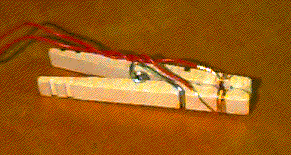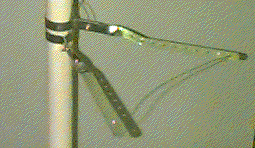 Hands
On Physics
Hands
On Physics
The Great Bungee Jump
CORE PROJECT
More of the Story
For previous installments of the story, look at the introduction
and inital investigations
The HOP students are now ready to build and test their scale model.
If they can full understand the scale model, they should be able to predict
whether a bungee jump is a feasible emergency exit. The next step will
be to test their predictions with a real bungee cord. They will push a
bag of sand out a tall building to simulate an emergency escape. They haven't
yet decided whether one of them will attempt the escape p; they want
to know a lot more beforing risking their necks!
So, the immediate need is to build a scale model of the bungee jump and
make some careful measurements of its performance. The timer will be key
to getting the data they need, if they can make it suffiencely accurate.
This involves calibrating it against known times.
Once they calibrate the timer, the students will get the data they need.
They will then try to make a mathematical model of the jump. If the mathematical
model fits the scale model, then the math will allow them to scale up to
the real thing.
Background
This project uses two different kinds of model: a scale model and a
mathematical model. Both kinds of models are used throughout science and
technology. There are mathematical models of molecules, global weather,
and galaxies. Scale models of rivers, racing boats, and rocket engines
are regularly used.
People build models because the real thing is too complex, dangerous, or
expensive. A simpler version of reality is easier to experiment with and
understand. A model is a way to help us understand the real thing. But
it is important to make a good model that captures all the major features
of reality. So, as you create your models, you should always be asking
whether the model is sufficiently accurate, whether the simplifying assumptions
that are made are justified.
Our scale model of the bungee jump is just a smaller version of a bungee
jump. Making it smaller means that we can bring it into the lab and make
careful measurements.
The mathematical model is based on Newton's Second Law that relates force
and motion. If we do the mathematics right and understand the forces, we
can be sure that it is accurate. One way of testing whether or analysis
is correct is to apply the mathematical model to a wide range of different
conditions. If it accurately predicts the motion of jumps from different
heights with different cords and masses, then we will have confidence in
the model.
Exactly these considerations help evaluate the value of all models. There
are dozens of mathematical models of hurricanes. The models people put
their faith in predict the path of past storms of all sizes. This is why
it is always important to test mathematical models against real data.
Questions:
The Design of the Core Project Apparatus
Our goal is to know exactly how long the jumper takes to fall to different
heights above the ground. The result of our study will be at least ten
accurate data pairs of the form (height, time). You are urged to figure
out your own way to obtain these data. We will describe one way to get
these data, but there are many other ways. If you develop a good procedure,
describe it and post it on the HOP server so others can use it.
To design a good model jump, the first question to ask is how you are going
to do the timing. Here are three possible ways:
- Use a photogate timer. There are many commercial timers that can be started and stopped by photogates, devices that sense a light beam being blocked. If you have one of these, you can set up one photogate to start the timer just as the jump begins and another to detect when the jumper reaches different heights. If you have the equipment this might be the most accurate.
- Use a TV camera. You can video the scale bungee jump and analyze the resulting tape. To do this, you need special computer hardware to digitize the tape and software to analyze it. This can be an extension. If you have the equipment, this is the fastest approach.
- Use the capacitor timer. We provide detailed instructions for this and it is inexpensive.
The Capacitor Timer Switch Design
The capacitor timer starts with both switches closed. When S1 is opened
it starts and when S2 is opened, it stops. How can we devise a way to make
these switch openings happen at exactly the right times? These are no ordinary
switches you can buy in the hardware store; you have to make them youself
from common parts.

Figure C1
Starting Switch
Switch 1. The photograph above shows a clever way to make S1.
The clothespin holds the mass and is the switch. Note how the indented
part of the jaws of the clothespin are both wrapped with bare copper wire.
Because these are indented, the wires do not touch and so the switch is
open as photographed. But if the clothes pin holds a mass that conducts
electricty, then the switch is closed; there is an electrical path between
the wires through the mass. By quickly opening the jaws of the clothespin,
you can start the jump, open the switch, and start the timer, all at the
same time.

Figure C2
Stopping Switch
Switch 2. This is one way to make S2. A wire stretched between two arms connects the arms electrically. Note that the two arms are attached to the pole at slightly different heights. As a result, they do not touch and there is no contact between them other than the wire. As long as the wire is in place, the switch made by the two arms is closed. But when the jumper hits the wire, it falls away and breaks the connection between the two arms. This opens the switch and can stop the timer.
Tower Design
The key design requirement of the bungee jump is reproducability. You
have to repeat the drop many times to measure the time it takes for the
mass to fall to different heights. This only makes sense if every drop
is exactly like the next; if you can reproduce the drop exactly the same
way each time.
To be reproducable, you need a way to always start the drop at the same
place and in the same way. This means you need a firm mount for the closepin
switch. You also need a way to adjust the height of switch 2 and setting
it to any height you desire.
One way we have found of achieving these design goals is to build a tower
from inexpensive plastic pipe. The top of the tower holds switch 1 and
the vertical part of the tower is a tube that holds the adjustable arms
that are switch 2. There are many other possible ways of meeting these
design goals. Let us hear original ideas you have for this.
Previous Page || Up a Level || Index || Next Page